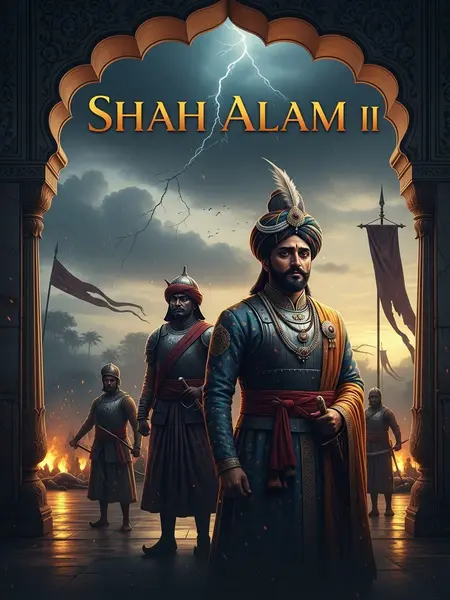Chapter 1: The Shadow from the East
In the 18th century, Burma was truly known as the "graveyard of empires."
Monsoon thunder rolled over the Irrawaddy, and the air in Calcutta hung thick with the scent of wet earth and burning lamp oil.
Those days, you only had to mention the name 'Ava' in the smoky corners of a Calcutta chai stall or in the marble corridors of Delhi's Red Fort for the entire room to hush. Overheard in a corner, a grizzled havildar muttered, "Arre, bhai, don’t even mention Ava—my cousin’s regiment never came back from those jungles." Burma’s tropical forests—so thick that sunlight itself seemed to get lost—were rumoured to swallow up whole armies, their bones left to rot under the relentless buzz of jungle insects. Amongst the rajas, nawabs, and even the British and French sahibs in Calcutta and Pondicherry, the Burmese were treated with a wary respect, bordering on fear. Even the most daring adventurers thought twice before provoking them. It was a time when everyone agreed, almost in whispers, that Burma was not to be trifled with.
During that era, the Burmese army campaigned across nearly the entire Indo-Chinese Peninsula. Countless foreign armies perished in the tropical rainforests during their clashes with the Burmese. The Burmese forces were armed with the most advanced muskets and cannons of the time, purchased from the British and French East India Companies. Even the British and French in Calcutta and Pondicherry hesitated to provoke them lightly.
The stories drifting over the Brahmaputra told of Burmese battalions cutting through dense bamboo thickets, their muskets flashing in the monsoon rain, elephants trumpeting as they hauled heavy French cannons up muddy slopes. When the Burmese set their sights on new lands, the village children in Bengal would be hushed by their mothers with tales of warriors who could move as swift as the jungle cats, faces smeared with oil, voices chanting prayers to unseen spirits. No wonder, then, that the Company Sahibs kept their distance, peering eastward with anxiety, their ledgers growing heavy with arms deals but light on actual engagement.
Eventually, the Burmese set their sights on the Mughal Empire under Emperor Shah Alam II.
In the labyrinthine alleys of Delhi, where the aroma of kebabs mingled with the musty scent of old parchment, whispers spread that the golden age of the Mughals was under threat. Shah Alam II, whose reign already trembled beneath the weight of Maratha and Afghan ambitions, now faced the shadow of a new, strange adversary. For the courtiers lounging in the Diwan-i-Khas, sipping sweet paan and debating the day’s petitions, the Burmese seemed like a fever dream—a distant terror, yet one that grew closer with each passing year.
To be honest, most people today can hardly imagine just how formidable Burma was in the 18th century. Without exaggeration, at that time Burma was the undisputed hegemon of all Southeast Asia.
In the words of the old chroniclers, "Burma was a lion among goats." It is difficult for us, sitting in our drawing rooms, ceiling fans spinning lazily overhead, to grasp the full force of a nation mobilized for war, its kings and commoners alike bent on conquest. In those days, the world south of the Himalayas was a game of chaupar, and Burma held the most powerful piece.
The reason is simple: their army was simply too powerful in battle.
Every paanwala in Patna or tavern keeper in Chittagong could recount tales of Burmese soldiers in gleaming breastplates, their war cries echoing through the monsoon-soaked night. Many a sepoy, posted along the swampy borders, would shiver at the memory of stories told by his father—stories of men who vanished into the emerald-green jungles, never to return, their fates sealed by the relentless advance of the Konbaung warriors.
From 1750 to the 1760s, in just over a decade, the Burmese army essentially wiped out all the states on the Indo-Chinese Peninsula.
1) To the northwest, the Burmese army destroyed the Ahom Kingdom and the Manipur Kingdom in eastern India.
2) To the north, they crushed the Shan States.
3) To the southeast, they conquered the Lan Xang Kingdom (in present-day Laos).
4) To the south, the Burmese were in the process of destroying the Kingdom of Siam (Thailand), had already captured the Siamese capital Ayutthaya, and Siamese resistance was on the brink of collapse.
Every season, it seemed, brought fresh news—columns of smoke rising where Ahom palaces once stood, Manipur’s rajas fleeing with whatever jewels they could carry, the bells of Ayutthaya loaded as trophies onto Burmese ox-carts. In Varanasi, pundits debated whether it was fate, the waxing and waning of dharma, or simply the superior steel and discipline of the Burmese host.
Moreover, if you think Burma was only strong within Southeast Asia, you would be mistaken.
Merchants in Surat, their ledgers filled with accounts of gold and precious stones, whispered to each other: the Burmese had grown so strong that even the white-skinned firangis now treated them as equals in the game of power. News arrived in the port cities that the Dutch had backed down from a dispute over timber, and the French and British now vied for the favour of the Burmese court, offering fine cannons and muskets for a chance at trade privileges.
At that time, the British in Calcutta (British East India Company), the French in Pondicherry (French East India Company), and even the Dutch and other European powers all treated the Burmese with great respect.
The sahibs in their big bungalows by the Ganges grumbled over their evening gin, careful not to raise their voices too high, lest a Burmese envoy—or worse, a Company informant—should overhear. Better, they agreed, to lose a few deals than risk the wrath of Ava’s unpredictable king.
First, Burma was a frequent purchaser of arms from them; second, the Burmese army was strong enough to influence their interests on the Indian subcontinent.
The ledgers of the Company, kept under lock and key in Fort William, revealed the truth: arms flowed eastward, silver and rubies flowed back. The British and French were merchants first, soldiers second, and nobody wanted to lose a profitable customer—or wake up one morning to find the Burmese banners fluttering at their doorstep.
This was the most powerful dynasty in Burmese history—the Konbaung Dynasty. Its hallmark was "classical militarism": the entire nation mobilised for war, strict military discipline, and excellent equipment.
The chroniclers in Delhi wrote of the Konbaung kings with a mixture of awe and dread, comparing them to the ancient Kshatriyas of legend—unyielding in battle, their every word law, their court a forge where warriors were tempered like steel. No other dynasty in Burma’s long history had marshalled such power, or inspired such fear across so many kingdoms.
After ravaging nearly the whole Indo-Chinese Peninsula, the Burmese found themselves with no worthy opponents nearby. So, they set their sights on what they considered their last rival—the Mughal Empire.
In the corridors of the Red Fort, gossip swirled: would the peacock throne finally face a challenger more terrifying than the Marathas or the Afghans? Paan-stained lips whispered that the Burmese king had set his eyes on Hindustan, and that the omens were not good for Delhi.
Simply put, they wanted to challenge the Mughals' status as the "overlord of South Asia."
For the first time in living memory, the Mughal court felt the chill of true rivalry from the east—a land beyond even the reach of the monsoon winds, now daring to stake its claim as the new overlord of the subcontinent. It was not simply a war of soldiers, but a clash of pride, prestige, and the very idea of what it meant to rule in Hindustan.







